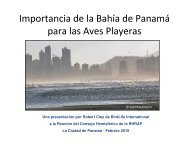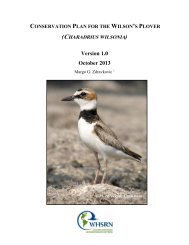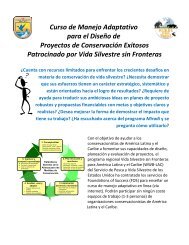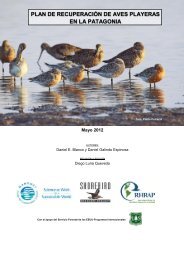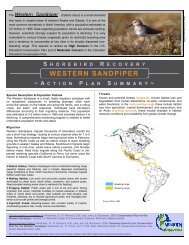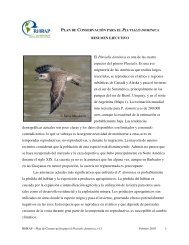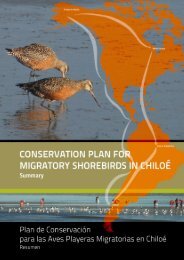Sanderling Plan - Western Hemisphere Shorebird Reserve Network
Sanderling Plan - Western Hemisphere Shorebird Reserve Network
Sanderling Plan - Western Hemisphere Shorebird Reserve Network
Create successful ePaper yourself
Turn your PDF publications into a flip-book with our unique Google optimized e-Paper software.
Pacific Coast, Southern Pacific Coast, U.S. Pacific Islands, Intermountain West, Northern<br />
Plains/Prairie Potholes, Central Plains/Playa Lakes, Upper Mississippi River/Great Lakes, Lower<br />
Mississippi Valley/<strong>Western</strong> Gulf Coast, Southeastern Coastal Plains/Caribbean, and the Northern<br />
Atlantic (to access Regional <strong>Plan</strong>s, see the U.S. <strong>Shorebird</strong> Conservation <strong>Plan</strong> website). Joint<br />
Venture <strong>Shorebird</strong> Implementation <strong>Plan</strong>s are currently available for the Central Valley, Northern<br />
Great Plains, Playa Lakes, Prairie Potholes, and Upper Mississippi River/Great Lakes (also<br />
available via the U.S. <strong>Shorebird</strong> Conservation <strong>Plan</strong> website).<br />
Some examples of priorities (from the U.S. Regional <strong>Plan</strong>s) that apply to the <strong>Sanderling</strong><br />
are listed below; however, Regional <strong>Plan</strong>s should be consulted for complete lists. The subset<br />
below is intended to highlight several recurring themes, as well as to provide a few examples of<br />
regional specificity.<br />
North Atlantic Region (Clark and Niles 2000). Conservation planning in this region requires<br />
placing special attention on establishing and maintaining ecologically healthy populations of<br />
Horseshoe Crabs in the mid-Atlantic region (through working with regulatory agencies,<br />
researchers, and commissions), and investing in planning and simulations for oil spill response.<br />
In addition it will be important to:<br />
o Identify and manage sufficient foraging and roosting habitat (intertidal complexes and<br />
impoundments) to maintain and enhance regional populations important in the region for<br />
shorebird species with overlapping requirements: <strong>Sanderling</strong>, Ruddy Turnstone (Arenaria<br />
interpres), Semipalmated Sandpiper (Calidris pusilla), Short-billed Dowitcher<br />
(Limnodromus griseus), Black-bellied Plover (Pluvialis squatarola), and White-rumped<br />
Sandpiper (Calidris fuscicollis).<br />
o Acquire land through partnerships to protect and manage habitat that benefits shorebirds<br />
(including the <strong>Sanderling</strong>) as well as other coastal wildlife species.<br />
Southeastern Coastal Plains–Caribbean Region (Hunter et al. 2000):<br />
o Provide high-quality managed habitat to support the <strong>Sanderling</strong> through better<br />
management of impounded wetlands;<br />
o<br />
Reduce and limit human disturbance of <strong>Sanderling</strong>s to tolerable levels using disturbance<br />
management throughout the year.<br />
WHSRN – <strong>Sanderling</strong> Conservation <strong>Plan</strong>, February 2010, v1.1 56




